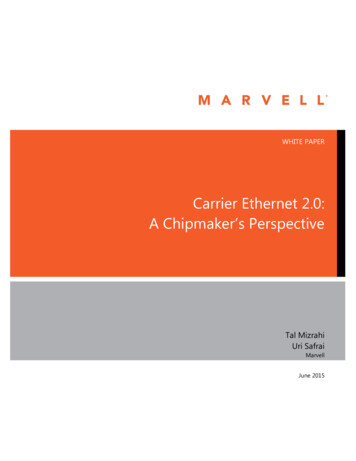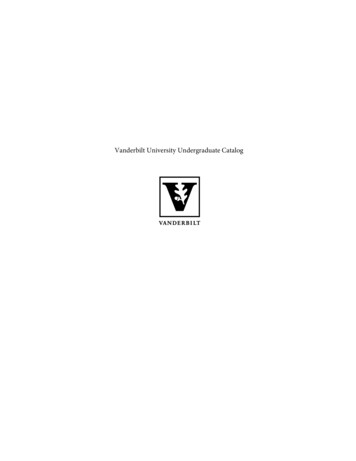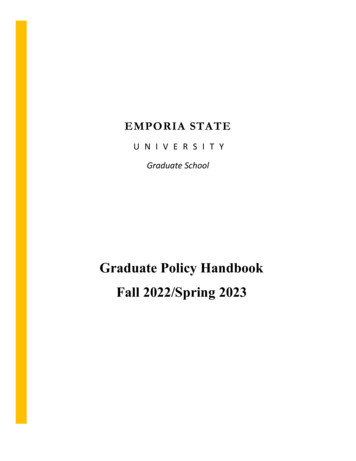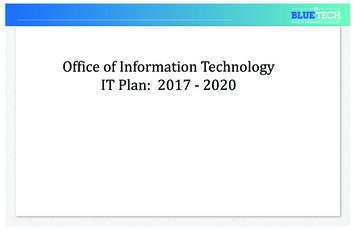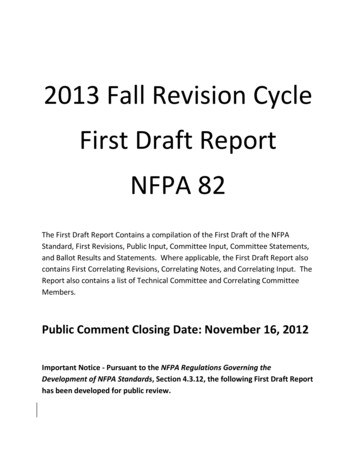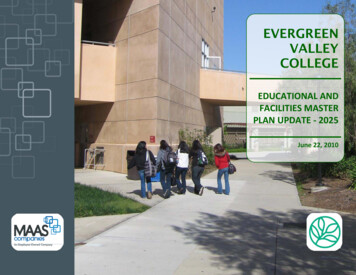
Transcription
EVERGREENVALLEYCOLLEGEEDUCATIONAL ANDFACILITIES MASTERPLAN UPDATE ‐ 2025June 22, 2010
Table of ContentsLETTER FROM THE PRESIDENT . 1INTRODUCTION. 3Scope Overview . 3Overview . 5Key Components to Planning. 5Board of Trustees Approval of Plan . 10INTERNAL ENVIRONMENTAL SCAN . 11Enrollment History . 11Race / Ethnicity Profile . 11Age Profile . 12Gender Profile . 12Time of Day Distribution . 12Enrollment Status . 13Student Origins . 13Degrees and Certificates . 13Transfer Data . 14Qualitative Input . 15Synopsis of the Survey . 15INTERVIEW SUMMARIES. 25Overview . 25Counseling Services . 25Financial Aid . 26DSP . 26EOPS . 26Cal-Works . 27Health Services . 27Student Support Services and Programs . 27Library and Learning Resources . 27Tutoring . 27Nursing and Allied Health . 28Associated Students/ Student Life . 28ESL Students . 29Facilities . 30Distance Education-Online Courses . 30Teaching and Learning Center . 30Additional Programs. 30Competition from Other Colleges . 30Transportation to EVC . 31Technology Needs . 31Class Availability . 31Working Cooperatively within the District . 31Data . 31Campus Maintenance . 32Special Programs . 32EXTERNAL ENVIRONMENTAL SCAN . 33Overview . 33The College in Relationship to the Nation . 33The College in Relationship To The State . 34Factors Impacting Enrollment . 34Population Growth . 35The College In Relationship To The Local Region . 35The Area to Be Served . 36Snapshot of the Service Area . 36Households by Income . 37Age Profile . 38Race and Ethnicity . 38Workforce Characteristics of the Local Region . 39Sources of Employment . 40Fastest Growing Occupations . 40Participation Rate . 42BASELINE CURRICULUM DATA . 45
June 22, 2010FUTURE CAPACITIES . 49TOTAL COST OF OWNERSHIP. 69Key Elements . 49Capacity for Future Growth . 49Existing Curriculum . 49The Internal and External Elements of the College . 49Weekly Student Contact Hours (WSCH) . 49State Chancellor’s Office Historical and Projected StudentEnrollment Information . 50Definition of Total Cost of Ownership (TCO) . 69Purpose of the Process . 69Objectives to be Achieved . 69Approval Process . 70Assessment Format . 70Implementation Process . 72Growth Rate Targets for WSCH and Enrollment . 50Profile of the Future Program of Instruction . 51Profile of the Future Program of Instruction . 51DETERMINATION OF FUTURE SPACE NEEDS . 53Space Requirements: Academic Program of Instruction . 53Academic Space Profile for 2015 . 54Academic Space Profile for 2020 . 57Academic Space Profile for 2025 . 60Space Requirements All Programs and Services of theCollege . 63Capacity / Load Ration Analysis. 64Current Facilities Project List . 64THE FINANCIAL PLAN . 65Financing Options . 65Suggested Financing Parameters . 68RECOMMENDATIONS . 73Student Experience . 73Instructional Program . 73Alternative Delivery Systems . 73Support Services . 73Outreach . 73Transportation . 73Future Development . 73ATTACHMENT A: SPACE DETERMINATION METHODOLOGY . 75Overview . 75Prescribed State Space Standards . 75Standards for Lecture Space . 75Standards for Laboratory Space . 76Non-State Space Standards . 77ATTACHMENT B: GLOSSARY OF TERMS . 79NOTE ON DISTRICT - WIDE PLANNING . 85FACILITIES MASTER PLAN . 86Facilities Master Plan Outline . 86Phasing Schedule. 87
June 22, 2010
June 22, 2010Letter From the PresidentWelcome to the 2010 Evergreen Valley College’s Educational &Facility Master Plan! The information compiled in this document is acritical component in our overall planning effort to address the futureneeds of the College and our students. I am extremely thankful andwould like to personally thank all members of our college communitywho have dedicated their time and energy into this planning effort.We are very fortunate to have a dedicated group of faculty, staff andadministrators who have contributed to this and other projects aboveand beyond their normal responsibilities to make this a better placefor everyone. I would also like to acknowledge the students for theirinvaluable contribution in the development of this plan.The future of the College and fulfilling our mission is not onlydependent upon outstanding people but also a solid planning processthat is transparent and inclusive with all segments of the college positively contributing to theprocess. Only with that high level of involvement and a continuous planning process with regularreview and self evaluation, can we achieve the College’s full potential. The 2010 Educational &Facility Master Plan will assist Evergreen Valley College in building a future that we can all be proudof and will benefit our current and future students and provide them with the skills to be successfulin their educational goals and dreams.David Wain Coon, EdDPresident, Evergreen Valley CollegeEvergreen Valley College Educational and Facilities Master Plan Update - 20251
2Maas Companies, Inc.
June 22, 2010IntroductionSCOPE OVERVIEWThe Evergreen Valley College Educational /Facilities Master Plan: 2010-2025 (“MasterPlan” or “Plan”) is a comprehensive planhighlighting the future educational andfacility needs of the College. This Plan hasbeen developed in response to theEvergreen Valley College Strategic Initiativesand provides specific direction andparameters for the implementation ofprograms, along with activities relating to theeducational and support service programs ofthe College. Further, the current and futurefinancial projections for the college and thedistrict are also taken into considerationwhen developing the recommendationsincluded in the Plan.The overarching objective of the MasterPlan is to develop a document thatestablishes a framework for the College toproject the instructional program, supportservices and facility requirements that will beneeded to meet the needs of studentsthrough the year 2025. As part of theprocess, the Plan also provides direction forproviding these programs and serviceswithin the anticipated financial parametersprojected through the year 2025.It is a dynamic document, flexible enough toadjust to new issues and needs that mayarise, but, with regular monitoring andupdating, will provide a solid, quantifiabledata base for future decision-making by thecollege and district.The Evergreen Valley College Educational /Facilities Master Plan: 2010-2025 has its rootsin the assessment and evaluation of bothqualitative and quantitative data relative tothe educational, support service and facilityneeds of the College as well as populationdemographics and employment informationfrom the college service area. Thisinformation served as a basis to explain thechanges that have occurred in the past andto forecast the future needs of the College.Simply stated, the objective of theEducational / Facilities Master Plan: 2010-2025is:Evergreen Valley College Educational and Facilities Master Plan Update - 2025EDUCATIONAL / FACILITYMASTER PLAN: 2010-2025OBJECTIVEDevelopadocumentthatestablishes a framework forthe College to project theinstructional program, supportservices and facilities that willbe needed to meet the needsof students through the year2025.3
The master planning process included thefollowing tasks:Conducting an overview and assessmentof the College and the area it serves: 4Conducting data research on the historicgrowth of student enrollment andweekly student contact hours (WSCH). Assessing the internal environment ofthe College relative to the currentcomposition/profile of the studentsserved.Conducting an external environmentalscan – viewing the College inrelationship to its service area andexternal environment.Creating a platform to support theforecast of future needs/direction of theCollege: Surveying faculty, staff, administratorsand students relative to the needs of theCollege Securing input from faculty, staff,administrators, students and communitymembers to assess current and futureneeds relative to the program ofinstruction and support services. Conducting on-campus interviews/meetings with deans, administrativestaff/managersandstudentstodetermine the future vision for theCollege. Conducting a course-by-course, sectionlevel analysis of the 2009-Fall Semesterprogram of instruction. Creating a baseline curriculum for FallSemester—2009 that reflects currentWSCH (Weekly Student Contact Hours)by discipline/program, by divisions andfor the College. Integrating the qualitative input fromthe interview process with quantitativedata. Reviewing with support staff the currentand projected level of services needed tosupport the overall instructional andsupport services proposed for theCollege.Maas Companies, Inc.
June 22, 2010 Defining the space capacities for WSCHgeneration through the year 2025. Creating a WSCH generation forecast bydiscipline/program and instructionalarea relative to the program ofinstruction for the future.OVERVIEWThe Evergreen Valley College Educational MasterPlan begins with an analysis of the studentswho attend Evergreen Valley College; whothey are, where they come from and whythey came to Evergreen Valley College.The students and their educational needs arethe basis for programs and services providedby the College. Without students, theCollege does not exist. From the studentswho attend Evergreen Valley College andthe programs of instruction they choose, allelse flows; the need for faculty and staff, theneed for support services and the need forfacilities and related instructional programand support service space. This concept ofusing a student-based model to generate allfuture planning efforts is essential giventoday’sever-changingeconomicenvironment and the increasing number ofstudents seeking to further their education atEvergreen Valley College.This Plan has established “baselines”, that is,reference points from which forecasts forthe future can be made. For the EvergreenValley College Educational / Facilities MasterPlan: 2010-2025, the baseline references havebeen established using fall-semester, 2009 asthe baseline semester. All external andinternal environmental scan informationincluded in the Plan is based on 2009-2010information.KEY COMPONENTS TO PLANNINGThere are many key components todeveloping a successful Master Plan. Someof the most critical elements are: The College commitment to a processwhich engages in a deep, honest, selfevaluation Hard analysis and observation of needsof the service area population Open-ended brainstorming of optionsor possibilities The development of clear choices;reflected in specific objectives andrecommendations Realistic objectivesimplementationandplansforSetting realistic objectives in a timely manneris essential to successful planning. Theobjectives set must be measurable. Goodplanning also addresses multiple issuesfacing the College and meeting the needs ofthe community it serves. Given the currentEvergreen Valley College Educational and Facilities Master Plan Update - 2025economic conditions, long-term, visionaryplanning will be critical in allowing theCollege to continue to meet the educationalneeds for residents of the college servicearea.History has proven that when the economysuffers or is in a recession, the demands foreducation increase. The increased number ofpeople out of work, combined with currentlyemployed people seeking to increase theirmarketability, is reflected in an increase ofenrollment at institutions of higher learning.However, the historically expected increasein student enrollment during the currentrecession has been further effected by thereduction in funding available to the Collegefrom the state and federal government, theon-going tuition increases and the availabilityof classes. These additional factors have allimpacted the enrollment pattern atcommunity colleges. Given the complexityand inter-dependence of these factors, theenrollment pattern over the past two yearsand also the pattern for the next two tothree years appears to be essentially statusquo. An annual increase or decrease of 1%2% in student enrollment is typical of whatcan be expected until the current economicclimate and level of unemploymentimproves.5
The initial effect of these external factorswere addressed by the College by reducingthe operating budget to only the essentialprograms and services.This budgettightening also included an effort to improvethe efficiency of the instructional programon a college-wide basis.The primarymethod used to achieve this objective was toimprove the average class size. However,any further budget reductions will result in areduction of the number of classes offeredby the College and a corresponding decreasein student enrollment. This will directlyinfluence the area residents trying to returnto college to gain new job skills. It is truly a“Catch-22” situation.The easy way out of this predicament is todo nothing and simply indicate that theCollege cannot help if the funding is notavailable. In a more proactive mode, theCollege needs to once again review allexpenditures and assess, on a class-by-classbasis, the instructional programs of thecollege while also reviewing all supportservices for cost-saving options. It may bepossible to make an adjustment in class sizesthat will minimally impact the quality ofinstruction in some disciplines while in othercases, such as laboratory classes, this is notpossible.However, the college mustdemonstrate to the community it is tryingeverything possible to accommodate theneeds of area residents.The current economic climate is the besttime to implement a systematic, thoughtfulplanning process to maximize the resourcesavailable to the College. An Educational/Facilities Master Plan, such as thisdocument, should take into considerationrelative issues facing the community,including the type of jobs projected for thefuture in the college service area and theeducational requirements needed to meetthat demand.Necessary adjustments can then be made tothe programs of instruction that will beneeded to support them. Elements, such asthe economy, may emphasize specific needsof particular instructional programs overothers. When implementing successfulplanning, the college must consider thatinstructional programs and disciplines donot grow at the same rate.6Maas Companies, Inc.
June 22, 2010Planning must look at the future and adjustprograms as necessary. Maintaining thebalance between fast growth and preservinga balanced program offering is essential. Theconsideration of issues such as these, givesthe College the opportunity to put in placethe programs it needs to meet the rapidlychanging needs of the community it serves.With good planning comes the need toestablish a system that allows decisionmakers the ability to measure the successand document the needs of the institution.As discussed, good planning will format thecurriculum to meet the projected futureneeds of the student population. It will placethe necessary emphasis on the identifiedinstructional programs that support jobs inthe service area and demonstrate that theCollege is providing and being responsive tothe educational/training needs of theresidents and businesses in the collegeservice area.AccreditationOne of the key factors influencing thisMaster Plan is that it is an essential elementwhich demonstrates that the College hasimplemented an on-going, comprehensiveplanning process that is consistent withWASC guidelines. Consistent with theadopted accreditation schedule, the Collegeis presently preparing for the nextaccreditation visit that will occur during the2010-11 academic year.The WesternAssociation of Schools and Colleges(WASC) presents key guidelines that aninstitution must follow to successfully meetthe needs of students and community. It isimperative that this 2025 Update of theMaster Plan reflect the standards determinedby WASC to maintain its currentaccreditation status. Accreditation providesa way to manage change through ng and reassessment. It validates theintegrity to the public and assures the localcommunity that the purposes areappropriate and are being accomplishedthrough a viable educational program.A valuable component of the accreditationprocess is the assistance it provides a collegein establishing its priority areas forimprovement as a result of the nt is a critical component toachieving full accreditation by WASC.The Evergreen Valley College Educational /Facilities Master Plan: 2010-2025, along withthe previous master plans completed in 2001and 2006, provides the College theopportunity to demonstrate to a visitingaccreditation team evidence of on-going,long-term planning and a commitment tohaving a dynamic master planning process inEvergreen Valley College Educational and Facilities Master Plan Update - 2025MISSION STATEMENTWith equity, opportunityand social justice as ourguiding principles,Evergreen Valley College’smission is to empower andprepare students fromdiverse backgrounds tosucceed academically, andto be civically responsibleglobal citizens.place to provide the basis for thedevelopmentofinstitutionalgoals,objectives and outcomes that are consistentwith guidelines identified in WASCaccreditation materials.History of the CollegePlanning for Evergreen Valley College beganon July 1, 1964, when the San JoséEvergreen Community College District wasformed as an independent college districtfrom what was known as the San Jose UnionHigh School District which served studentsfrom Kindergarten through Grade-14. Thepresent site for the College was purchased in1967 and was named Evergreen ValleyCollege on June 16, 1970. Master planning7
then ensued and the first two buildings(Acacia and Roble) were completed in 1975.With the completion of this initial phase ofbuildings, Evergreen Valley College, as thesecond college in the San Jose-EvergreenCommunity College District, began offeringclasses on campus in 1975 with a totalenrollment of 3,000 students. Today, theCollege enrolls over 12,000 students frommore than 70 countries.Initially, the college was tuition-free, offeringclasses in the day and evening, includingSaturdays.The inititialorganizational structure ofthe College was a “Cluster”concept of interdisciplinaryeducation.Within eachcluster were centers ofapproximatelyfifteenfacultymemberspercenter. Cluster Acacia hadfour centers, while ClusterRoble had two centers.Each Cluster had a careerfocus as well as supportinggeneraleducationcurriculumandacounselor. By 1993, theClusterconceptwasabandoned due to thegrowingstudentpopulation and a moretraditionaldivisionalstructure was created forthe college.In terms of facilities, in1979, the Library openedas a third building in the8clusters.This building has now beenremodeled and serves as the Student Center.In 1984, the Cedro building opened toaccommodatethegrowingstudentpopulation of the College.Since 2002, local capital construction bondshave been approved by district voters whichfunded the renovation of existing facilitiesand the construction of new facilitiesincluding the Learning Resource Center(Library), a Student Center, an Observatoryand a Center for the Arts. Currently inplanning is an addition to the physicaleducation area for exercise and fitnessprograms. As part of the current masterplanning process, it is anticipated that anenrollment of approximately 12,000 studentswill continue to be the maximum, oncampus enrollment for the College.Evergreen Valley College StrategicInitiativesThe Mission Statement and StrategicInitiatives establish the parameters forplanning and decision-making at all levels ofthe College. These initiatives were used as aguide while developing the Educational /Facilities Master Plan: 2010-2025. TheStrategic Initiatives are rooted in theCollege’s Mission Statement. The StrategicPlanning Initiatives, developed by thefaculty, staff and administration of theCollege provide the foundation for theMaas Companies, Inc.
June 22, 2010development of all planning efforts by theCollege. All programs, divisions and thecollege establish annual “Commitments toAction” (CTAs), which are the foundationof Strategic Planning.The Strategic Initiatives include goalsthe College aims to achieve.Student-Centered: We provide access toquality and efficient programs and servicesto ensure student success. Areas of focusare: Access Curriculum and Program Development Student Service OfferingsCommunity Engagement: We willtransform the college image and enhancepartnerships and community, business andeducational institutions. Areas of focus are: Visibility Strategic Partnerships College in the CommunityOrganizational Transformation: Wecreate a trusting environment whereeveryone is valued and empowered. Areas offocus are: Community Building Employee Development Transparent InfrastructureBy focusing on the established StrategicInitiatives, the College has made significantimprovements in institutional effectiveness.The faculty and staff of the College arefocused on improving the effectiveness ofthe institution as a whole and are committedto evaluating what specific departments orprograms can do to help the College reachthe overall objectives set forth through theseinitiatives. The College faculty, staff andadministration dedicate time each year toreview the progress that has been made oneach objective and develop future actionplans that will continue to support theStrategic Initiatives.The Plan that follows is a road map forimplementation that, if followed, will achievethe guidelines set by WASC. It affirms theproper structure for the institution beingstudent-centered and well-versed in a longterm comprehensive planning effort that isbased on the essential standards, principles,and guidelines established by WASC.Evergreen Valley College Educational and Facilities Master Plan Update - 2025In the sections that follow, a detailed analysisis presented of qualitative and quantitativeinformation that is needed to implement theEvergreen Valley College Educational / FacilitiesMaster Plan: 2010-2025. Included in the Planare the following sections: External Environmental Scan-Identifiesnational, regional and local trends thathave significant impacts on the future ofthe College. Internal Environmental Scan-Identifiesthe students who attend the College,where they come from, and thedemographics of the College. InstructionalServices Future Projections for InstructionalPrograms and Support Services A Financial Plan along with a Processfor determining the Total Cost ofOwnership (TCO) A quantitative assessment of current andFuture Space Capacities for bothinstructional and support services A campus Facilities Master Plan through2025 RecommendationsDistrictProgram and SupportforCollegeand9
BOARD OF TRUSTEES APPROVAL OFPLANAs part of the planning approval process,the Educational / Facilities Master Plan: 20102025 for each College as well as the San JoseEvergreen Community College District Educational/ Facilities Master Plan: 2010-2025 will bereviewed utilizing the shared governanceprocess for the Colleges and the District.Upon approval of the draft Plans by theconstituent shared governance groups, theCollege Plans and the District Plan will bepresented to the District Board of Trusteesfor approval.10Maas Companies, Inc.
June 22, 2010Internal Environmental ScanENROLLMENT HISTORYStudent enrollment at Evergreen ValleyCollege has experienced both increases anddecreases over the past 6 semesters. Themost notable increase, 1,579, was reportedbetween fall 2007 and spring 2008.Conversely, the most notable decrease,2,069, was reported between fall 2008 andspring 2009. It is interesting to note thatenrollment in spring 2009 was the lowest theCollege has reported since fall 2006. Duringeconomic downturns, community collegesgenerally report an increase in enrollmentdue to a higher number of people seeking toincrease their education level and jobmarketability in more competitive workenvironments.population at the College.The next largest groups are White/ NonHispanic, Filipino and Unknown eachrepresenting 9% of the student body. PacificIslander, American Indian/Alaskan Native ,Pacific Islander and Other (Non-White)each accounted for 1% of the overall studentpopulation at EVC during the Spring 2009semester.RACE / ETHNICITY PROFILEEvergreen Valley College has a diversestudent population which represents avariety of ethnicities. The largest ethnicgroups on campus are Asians and Hispanics;both individually account for33% of the overall studentEVC STUDENT ENR
Evergreen Valley College Educational and Facilities Master Plan Update - 2025 1 Letter From the President Welcome to the 2010 Evergreen Valley College's Educational & Facility Master Plan! The information compiled in this document is a critical component in our overall planning effort to address the future needs of the College and our students.
